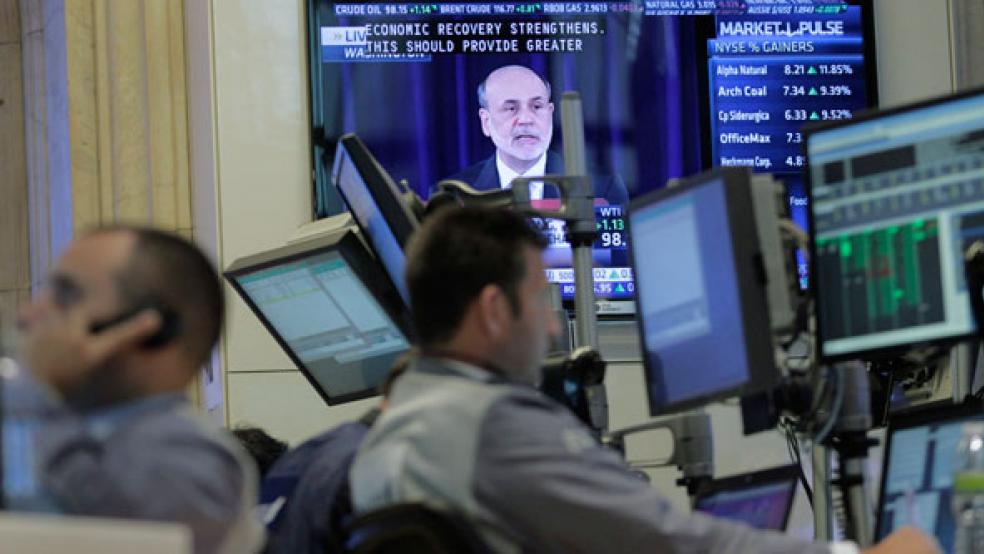The Federal Reserve appears ready to tap the brakes on its monthly $85 billion bond-buying program, even though the jobs picture still looks dismal and an upcoming federal budget showdown could sideswipe the economy.
Fed officials begin a two-day meeting on Tuesday to decide whether to reduce the size of its purchases, slowing down the cash infusion that’s known as QE3, which stands for the third round of quantitative easing.
RELATED: GOP AIMS AT OBAMACARE WITH BUDGET BULLETS
Fed Chairman Ben Bernanke said three months ago that any tapering would depend in large part on a falling unemployment rate. The jobless rate dropped last month to 7.3 percent, down from 7.6 percent when Bernanke spoke in June.
The decision is a test of whether the economy can continue to improve without leaning so heavily on government crutches, a choice that’s not as cut-and-dried as the unemployment rate would suggest. More than 300,000 Americans left the workforce in August, almost double the number who found jobs. And President Obama warned on Monday about the “economic turmoil” that would be unleashed if he fails to craft a deal on the 2014 budget and the debt ceiling with House Republicans.
Several GOP lawmakers have threatened to withhold an increase to the government’s $16.7 trillion borrowing authority unless Obamacare is delayed and defunded. The president vowed not to “negotiate over the full faith and credit of the United States,” reminding Congress that the previous duel over the debt ceiling in 2011 led to a serious economic slowdown.
“It’s never been easy to get 535 people here in Washington to agree on anything—and budget battles and debates, those are as old as the Republic,” Obama said. “Having said that, I cannot remember a time when one faction of one party promises economic chaos if it can’t get 100 percent of what it wants. That’s never happened before. But that’s what’s happening right now.”
House Speaker John Boehner (R-OH) learned last week that an intractable group of his fellow Republicans rejected his plan to keep the government operating through mid-December, as the plan’s mechanism to defund Obamacare could easily be overturned by the Democratic majority Senate.
The possibility of a government shutdown makes the Fed tapering risky. It could trim its purchases by $10 billion or $20 billion—according to many Wall Street economists—only to then ramp up its bond-buying after a budget breakdown.
A WEAKER JOBS RECOVERY
Obama tried to reframe the debate about the budget around job creation, although his messaging has done little to change the trajectory on Capitol Hill. But the figures buried in the monthly job reports indicate that the recovery has been much weaker than the president would care to admit. They indicate that QE3 has either been an extremely weak effort to boost hiring, or that more stimulus from the Fed, Congress, and the president is desperately needed.
“The labor market is in bad shape,” said Michael Strain, an economist and resident scholar at the conservative American Enterprise Institute. “We’re still trying to feel our way through this stuff. It’s not crystal clear what’s going on.”
RELATED: JOBS STILL THE BIGGEST CHALLENGE FACING U.S. LEADERS
The source of the confusion is the labor participation rate. It stands at 63.2 percent, which, disturbingly, is its lowest level in 35 years. The unemployment rate only measures people who have a job or are hunting for one, not those who left the labor force.
There are two major reasons why that rate has dropped and economists are still arguing over which one matters the most. The lower rate reflects an aging baby boomer population that is entering retirement, but also that thousands of discouraged workers cannot find a job.
If the drop is mostly a demographic trend, then there is less reason to panic about labor force participation. But should it indicate that Americans have given up on working after a brutal recession, then alarms should be going off at full blast.
Strain said that the 2008 financial crisis accelerated the long-term trends of disappearing mid-skill jobs and baby boomer retirements. One of the main job stats that he follows is the percentage of 25-to-54 year-olds who are employed. This includes everyone who is prime working age, excluding Americans who are in school, retired, or have stopped looking for work.
RELATED: GUESS WHO’S HOGGING ALL THE PART-TIME JOBS?
Before the recession, the employment to population rate for this age bracket hovered around 79 percent. It has stayed relatively flat at 75.9 percent for much of 2013, a sign of slack in the economy as workers in their prime cannot find paychecks.
The liberal Economic Policy Institute recently highlighted another indicator of weakness. The JOLTS data—short for Job Openings and Labor Turnover Survey—looks at churn in the employment market. There were 3.7 million job openings in July. That might sound like a lot, but it’s 800,000 fewer than in a pre-recession 2007, the think tank said in a blog post.
Each of these stats reveals a fragile economy and incomplete recovery, but it’s unclear how the Fed’s Open Market Committee weighs these figures when setting policy.
Bernanke has said the Fed will use the unemployment rate as a threshold and consider ending QE3 when the jobless rate reaches 7 percent. There is also the possibility that Fed officials have already factored in these troubling stats and decided that tapering—since bond purchases cannot continue indefinitely—should start anyway.
Benn Steil, a senior fellow at the Council on Foreign Relations, noted that the Fed is looking for data that’s “broadly consistent” with the central bank’s forecast. Steil noted that the Fed did not expect the unemployment rate to reach 7.3 percent—as it did in August—until the fourth quarter of the year, a sign that despite any troubling signals that tapering should begin.
“The bottom line is that if an imminent Fed taper is misguided,” Steil wrote in a blog post, “it is not misguided because of the August jobs report.”




